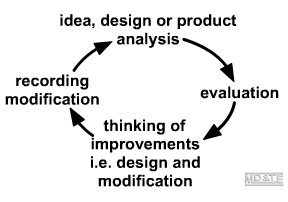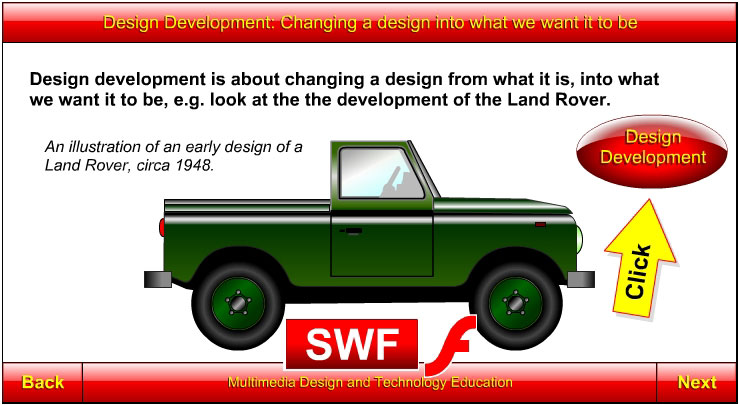What is design development?
Design development is the process of improving a design or making it suitable for a particular purpose. Design development can change a hazy idea into a clear and detailed plan and it can change a design from what it is into what we want it to be. These changes to a design are called modifications.
Design development involves:
- looking closely at an idea, design or product (i.e. studying and analysing it to learn something about it)
- judging it (i.e. evaluating it. An objective evaluation involves testing a product or design to check that it matches the specification precisely; a subjective evaluation involves making judgments by applying emotions, prejudices, likes and dislikes)
- thinking of how it could be improved (i.e. how it could be modified and made better)
- recording the modified design (usually by drawing or modelling the design).
This process can be repeated over and over again until a suitable design is found. Design development may be carried out by one person or the process of analysis, evaluation and modification may be carried out by groups of people. Iterative design developmentIterative design development is a cyclic process of analysing, evaluating and modifying ideas, designs and products. |
 |
Each modification may be a small change to the previous design or the modification may be a major change.

Sequential design development
A linear model of the design process is an example of sequential design, i.e. start with a design brief » analyse it » specify what the solution should be like » design it » make it » implement it.
However, a design can be developed by starting with an idea and making a series of modifications in a logical sequential order, e.g. by making minor changes to the design of the chair shown below.

A designer may use the iterative method of design development, or a sequential method, or both, e.g. a designer may record a sequence of design ideas quickly then analyse and evaluate the latest design before progressing further in a sequence of new ideas.
There are two starting points for design development
-
The first starting point is an idea for a design. The design development process involves developing a hazy idea into a clear and detailed design.
-
The second starting point involves taking an existing design and modifying it in some way, i.e. developing the design from what it is into something new and better.
Both types of design development involve planning and recording changes made to a design.
1. Developing a hazy idea into a detailed design

Click on the screenshot above to view the "developing a hazy idea" animation by Laszlo Lipot
An image showing the Flash animation logo Flash animations are embedded into the pages of all my D&T Modules but there are pictorial links to the animations on this web site so that devices that cannot play Flash animations will at least show a jpeg screenshot of the animation. If your PC or personal digital assistant (PDA) can play Flash animations you may click on an image showing the Flash animation logo |
2. Changing a design into something new and better

Click on the screenshot above to view the "Design Development" animation by Laszlo Lipot
Designs may be developed in many ways, including:
- Refining a design, i.e. adding details or making small changes that make the design better in some way, e.g.
- adjusting the size of parts of a design of a steel towel rail so that standard sizes of steel tube and box section may be used to make it
- specifying the finish applied to the various parts of a design
- specifying the details of components used in the design, e.g. materials, sizes and types of screws, nuts and washers.
- Making the design more suitable for a particular purpose, e.g.
- modifying the design of a camera to make it waterproof and shock resistant
- adding wheels to a large suitcase to make it easier to use
- modifying the design of a bicycle to make it more suitable for a particular terrain or activity.
- Making the product more suitable for a particular user, e.g.
- making bicycles in various sizes, styles, colours and materials
- making spectacle lenses for a particular user
- making a product more usable for a person with special needs.
- Changing the manufacturing material, e.g.
- making garden furniture from plastics so that it will be more weather resistant
- making the design suitable for a particular production method, e.g. injection moulding
- changing to sustainable materials
- giving more choice, e.g. window frames manufactured from materials such as metals, woods, plastics
- furniture made from materials including glass, steel, leather, laminated wood, concrete.
- Changing the manufacturing processes used, e.g.
- matching the materials used in the product
- because new processes such as the use of computer controlled machines are employed
- because the design enables changes in the way that components are cut, shaped, finished, assembled and fixed together.
- Making the product more suitable for manufacturing in large quantities, e.g.
- extruding materials
- using injection moulding techniques
- using press tools
- using automatic and computer controlled machines.
- Making the product or components of the product conform to a particular standard, e.g.
- working as accurately as is required
- using materials of the specified quality
- making the product to the specified safety requirements
- giving the product the specified quality of finish.
- Making changes to the size, shape or weight of the product, e.g. in products like:
- golf clubs
- fishing weights
- bicycles.
- Making the product suitable for a particular environment, e.g.
- making a camera waterproof (creating an underwater camera)
- strengthening cycles components in order to withstand very heavy use (e.g. mountain bikes)
- eye protection (e.g. safety glasses, sun glasses, welding goggles).
- Making changes to the finish applied to the product, e.g.
- changing the colour
- changing the texture
- changing the material
- applying finishes that offer resistance to weather conditions
- applying teflon to create a non stick finish.
- Making changes to the way that the product is used, e.g.
- look at how: telephones have developed
- CD players etc. have developed
- computers have developed
- the products that have remote control devices have increased
- the convergence of technologies has allowed products to be multi-purpose, e.g. a mobile phone is also a computer, camera, video recorder, games console, etc.
- Making changes to the product’s use of energy by:
- reducing the amount of energy used by a product by reducing its weight;
- reducing friction between moving parts;
- improving the transmission of energy in systems.
- Making the product safer for the manufacturer, the users, the maintainers and others who may be affected by the product, e.g. by making risk assessments of the activities involved in the:
- production
- transport
- use
- maintenance
- disposal of the components of the product and incorporating the findings into the design.
- Making the product parts easy to recycle, e.g. by:
- reducing the number of parts in the product
- reducing the variety of materials in the product
- by labelling the materials used in the product
- making the product easy to take apart.
- Improving the product quality, e.g. by insisting on excellence from everyone involved in the product and the systems used for designing, manufacturing, distributing and marketing the product.
- Improving the product performance, e.g. by:
- improving the design
- using better quality materials and components
- improving accuracy in production
- improving quality of assembly.
- Improving the product cost, e.g.
- by reducing production costs
- reducing assembly costs
- reducing transport and storage costs
- value analysis.
- Improving the way the product may be maintained, e.g.
- by making cleaning and lubricating easy
- improving quality and increasing the time interval between maintenance programmes.
- Improving the ease with which the product can be disassembled, e.g.
- to ease the replacement of parts;
- because of the requirement to disassemble/dismantle products and recycle components.
| Click here to view the PDF version of this resource. | 
|
 |